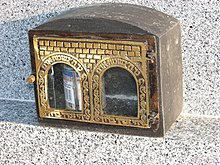Yahrzeit candle





A yahrzeit candle, also spelled yahrtzeit candle or called a memorial candle, (
Name
The word "
In Hebrew, the candles are also called Ner Neshama – a candle for the soul.[2]
Remembrance
The use of a
The candle is also lit before
In all cases, the candle is lit before sundown. This is because in Judaism, days begin at sundown, in accordance with Genesis, e.g., 1:5: "And there was evening and there was morning, one day."[4])
It is also customary to light the candle during the shiva, usually a larger one that lasts the entire seven days. In the absence of a seven-day Shiva candle, seven yahrzeit candles can be lit on successive days (but not in violation of Shabbat).
Today, some people use an electric yahrzeit candle that plugs into the wall instead of a candle for safety reasons, such as in a hospital.[5]
Source
The custom of lighting a yahrzeit candle comes from the Book of Proverbs 20:27 "The soul of man is a candle of the Lord."[3]
A candle similarly appears in the midrashic description of Aaron's death:
[God] said to [Aaron]: "Enter the cave", and he entered. He saw a bed made and a candle burning. [God] said to him, "Go up on the bed", and he went up. "Spread out your hands", and he spread out his hands. "Close your mouth", and he closed his mouth. "Close your eyes", and he closed his eyes. Moses immediately desired that his death would occur the same way.[6]
Holidays
Yahrzeit candles are also commonly used on holidays, for reasons of convenience rather than symbolism.
On
48 hour and 72 hour candles have also been manufactured, for holidays that last more than one day.
In culture
- After Kings of Israel Squarewhere he was killed were dubbed the "Youth of the Candles" (נוער הנרות, noar hanerot) after the many yahrzeit candles they lit.
- Yahrzeit candles are often lit by many Jewish communities on Yom HaShoah (Holocaust Remembrance Day) in remembrance of those who were murdered in the Holocaust.
Gallery
-
The grave of David Ben-Gurion, the first Prime Minister of Israel, along with his wife. His tomb is covered in yahrzeit candles and stones.
-
The standard Israeli military graves ofJonathan Netanyahu, and others with a yahrzeit candle in a box for each grave
-
The assassination site of Israeli Prime MinisterYitzchak Rabin. It is usually filled with yahrzeit candles and flowers.
-
Yahrzeit candles and signs entitled "2009 Tel Aviv gay centre shooting
-
Yahrzeitlicht from Lengnau in Aargau (Switzerland), 1830, now in theJewish Museum of Switzerland
See also
- Bereavement in Judaism
- Grave candle
- Yahrtzeit
References
- ^ Memorial honors Yitzchak Rabin, The Daily Pennsylvanian, Brennan Quinn, December 6, 2000
- ^ Ner Neshama, Morfix Dictionary (in Hebrew)
- ^ a b c The Jewish Religion, Louis Jacobs, Oxford University Press, 1995
- ^ Tanakh: The Holy Scriptures: The new JPS translation according to the traditional Hebrew text. Philadelphia and Jerusalem: Jewish Publication Society. 1985. p. 3.
- ^ Sari Bloom. "Spending Shabbat in the ER".
It was the first time in my married life that I was unable to light Shabbat candles on Friday afternoon (due to hospital regulations).
- ^ Rashi, Numbers 20:26







